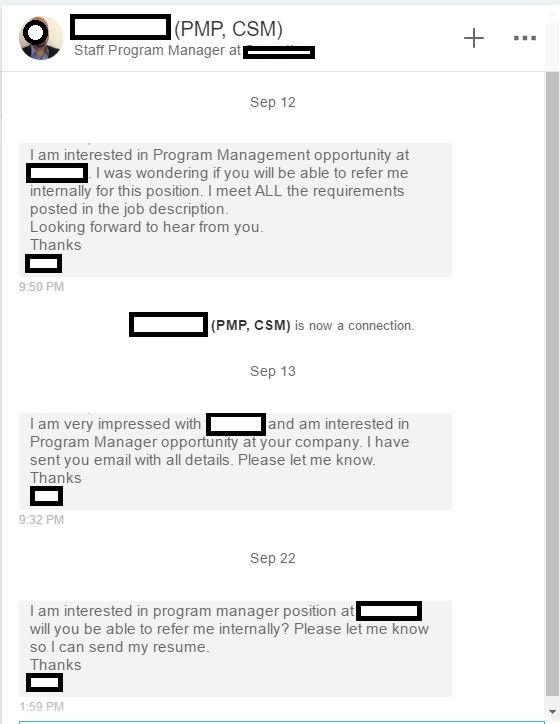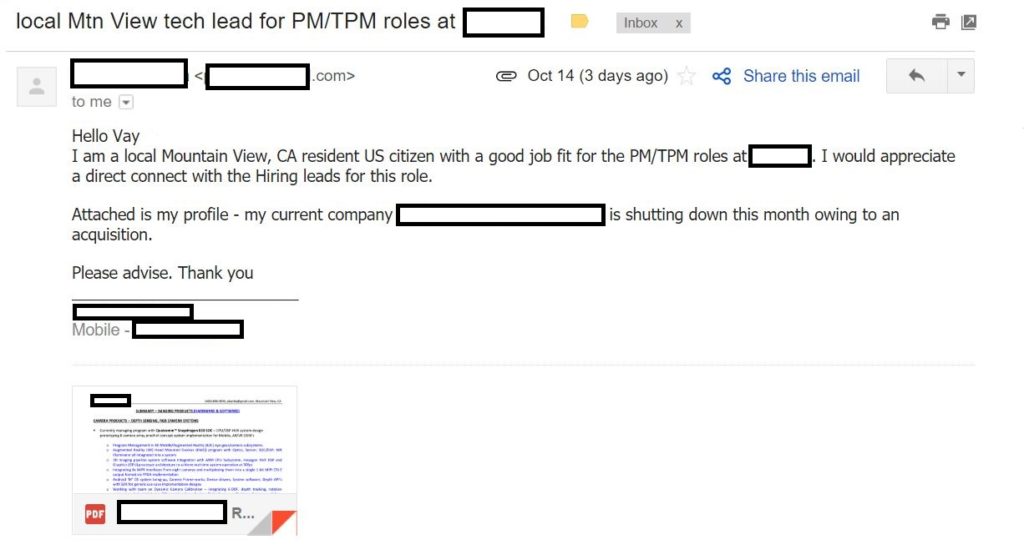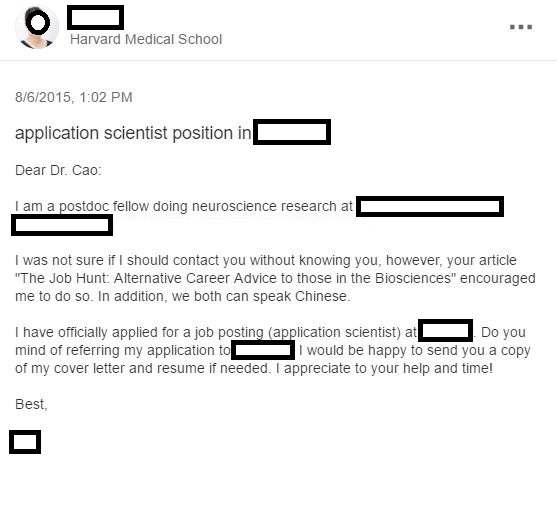Wrong Ways to Ask for Job Referrals – And Why!
While I’m not in my company’s HR department, we’re small enough that personal referrals do make a difference. Individuals can indeed advance applications to the right person, because employees are more likely to work directly with many upper management-level personnel in small companies.
Since I’ve started, I’ve gotten my fair share of people cold contacting me, many with PhDs responding to job postings, asking for an internal referral for open positions at my employer. I acted on very few of them. Why?
Let’s check out a few examples of messages I’ve received, with identifying information removed for privacy. I will preface this discussion by saying outright that in no way am I criticizing the fact that these people reached out. In fact, they are doing the right thing, working on getting themselves out there. I commend them on sending these messages, but I acted on none of them, which is a problem.
Let’s see how we can change that.
Example 1. I Don’t Care What You Appreciate. Show Me How I Should Appreciate You.
- The Good:
- This person reached out with their materials attached. If you’re reaching out directly to ask for a referral, don’t ask for permission to send materials. Just attach your final resume or cover letter and be direct. Chasing people by email is inefficient and you risk your email thread getting buried and forgotten. If you reach out conversationally or for more information before requesting a referral, then you can hold off on attaching your materials until you’ve made that connection you’re looking for.
- This person made it clear that they are local to my company’s area. This makes it easier for a company to bring that person in for an interview, so isn’t a bad thing to point out. However…
- To Be Improved:
- The only reasons this person gave to entice me to look at their resume is the fact that they think they’re a good fit, and they are local. This isn’t enough. I don’t know you, so I don’t trust that your opinion matters. Being local alone doesn’t show me what you bring to the table as a future colleague.
- This person put very little information upfront to make them attractive to me. Do you know our product or our audience? How does your experience relate to our needs?
- Don’t put qualifying information in the first email. I don’t need to know why you’re looking for a new job. I just want to know that your materials are likely worth the time for me to check out, and potentially pass along to my team or colleague.
Example 2. Don’t Do the Same Thing and Expect Different Results.

- The Good:
- This person reached out more than once after not getting an initial reply. People are busy and they don’t always check their email or LinkedIn, or they might have just forgotten to reply. Checking in after a week or two of not hearing anything is always a good thing.
- To Be Improved:
- You probably see that this person has the same issue as in the first example. I know they’re interested in a particular position, but I’ve been given no reason to pursue the reason why.
- This person is not someone I already know, so I don’t trust that they fulfill all the requirements of the position just because they said so. They need to give me a little more proof that they know what we do and what we care about as a company or department. Remember that not every person you ask for a referral for is an expert in the position you’re interested in, so that makes it even more important that you provide some up front reasons why you are going to be worth their time to check out or pass along to others.
- This person essentially repeated the same email three times, without providing any new information or reasons for me to respond. If the first pass didn’t get a response, either just write a simple “Just checking in” email, or provide a few different points in a followup email. Perhaps have a different ask, like request an informational interview over coffee.
Example 3. Appear Confident and You Will Seem Confident.
- The Good:
- This person already applied to a position and reached out to see if they could get a means of standing out above the rest with an internal contact. Although it might have been better to do it the other way around in order to ensure their application is the best it could be before submitting, reaching out is still better than not reaching out.
- To Be Improved:
- This person gave two reasons why I should feel good about interacting with them: they read an article I wrote, which is great, and we speak the same language. While of course I’m happy to hear my article made an impact on them, it doesn’t satisfy my need to know that they know anything about the job or position they applied for. Same for the language skill, given it doesn’t necessarily add to the strength of her application.
- This person sounds insecure. Everyone likes to be reassured, but the email where you’re asking for an internal referral is not the time. If you sound uncertain of what you’re doing, your uncertainty can reflect back on how the recipient sees you. “If you’re not sure about reaching out, how sure are you that you’re a good candidate for this job?”
The Right Way to Ask for A Job Referral
Think about how you react to cold texts or calls. Now think about how that cold text or call could be made more trustworthy or interesting. The person could say you’re mutual friends with someone, and that person suggested that you two connect. The person could say that they have something you have a genuine need for or interest in, and start a conversation centered around mutual benefits. They could offer you something in exchange for your time, such as coffee or lunch as an expression that they value your time or expertise.
If directly asking for an internal referral makes you nervous, ask for a meeting or a phone call instead (informational interview). Different people will respond in different ways, so don’t lock yourself into just one way or ask when reaching out.
Conclusion: The #1 hurdle for all cold emails asking for a job referral is the immediate “I don’t know you” reaction from the recipient.
This leads to a lack of trust, and thus interest, in the message, unless the message somehow breaks through that initial barrier. And it can be done. There are three main ways to accomplish this:
- Demonstrate real knowledge of what the recipient is interested in, or wants, and do so confidently (I know data analysis methodologies is a growing bottleneck in neuroscience)
- Provide a genuine connection to warm up the initial reaction (I also graduated from Arizona State; Your PhD mentor told me to reach out)
- Provide at least a hint of a benefit to the recipient (I want to contribute to your team’s growth; I believe I can greatly increase your project’s efficiency).
Notice how important being honest and real is. A lot of academics are afraid that networking, asking for referrals or cold contacting is slimy and fake. Not true: bad networking is slimy and fake. Effective networking always works best when everyone is being real.
Apply this thinking when you’re ready to ask for referrals.
DO ask for them. Don’t be afraid of not getting the right tone right away; the key is practice.
“Address the #1 hurdle for all cold emails asking for a job referral: get past the “I don’t know you” reaction from the recipient with the above three points.”
How has your luck been in reaching out to cold contacts for job referrals or informational interviews?
Email me if you have any questions, comments or requests for the next discussion!
Yours,
-Vay
Join the FreethePhD list to get more information like this!






